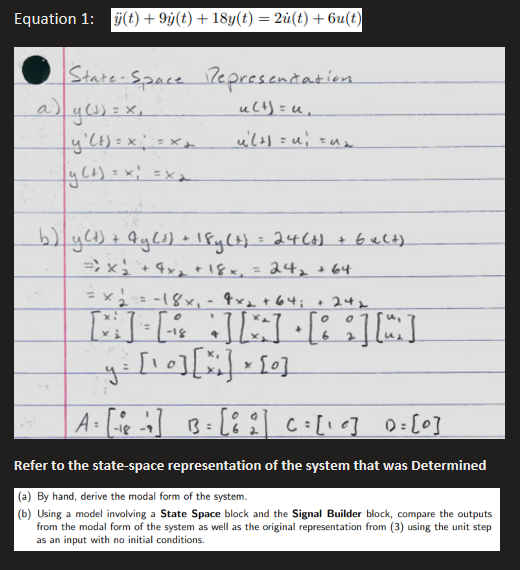Home /
Expert Answers /
Electrical Engineering /
show-all-work-use-nbsp-simulink-in-matlab-for-part-b-equation-1-quad-ddot-y-t-9-dot-pa705
(Solved): Show all work. Use Simulink in MATLAB for Part (b). Equation 1: \( \quad \ddot{y}(t)+9 \dot{ ...
Show all work. Use Simulink in MATLAB for Part (b).
Equation 1: \( \quad \ddot{y}(t)+9 \dot{y}(t)+18 y(t)=2 \dot{u}(t)+6 u(t) \) State. Space Depresentation a) \[ \begin{array}{ll} y(1)=x_{1} & u(t)=u_{1} \\ y^{\prime}(t)=x_{1}^{\prime}=x_{2} & u^{\prime}(1)=u_{1}^{\prime}=u_{2} \\ y(t)=x_{1}^{\prime}=x_{2} & \end{array} \] b) \( y \) \[ \begin{array}{l} y(t)+4 y(t)+18 y(t)=24(t)+6 u(t) \\ \Rightarrow x_{2}^{1}+4 x_{2}+18 x_{1}=244_{2}+64 \\ =x_{2}^{1}=-18 x_{1}-4 x_{2}+644_{1}+24_{2} \\ {\left[\begin{array}{l} x_{1} \\ x_{2} \end{array}\right]=\left[\begin{array}{cc} 0 & 1 \\ -18 & 4 \end{array}\right]\left[\begin{array}{l} x_{2} \\ x_{2} \end{array}\right]+\left[\begin{array}{ll} 0 & 0 \\ 6 & 2 \end{array}\right]\left[\begin{array}{l} u_{1} \\ u_{2} \end{array}\right]} \\ y=\left[\begin{array}{ll} 1 & 0 \end{array}\right]\left[\begin{array}{l} x_{1} \\ x_{2} \end{array}\right] \times[0] \\ A=\left[\begin{array}{cc} 0 & 1 \\ -18 & -9 \end{array}\right] \quad B=\left[\begin{array}{ll} 0 & 0 \\ 6 & 2 \end{array}\right] \quad C=\left[\begin{array}{ll} 1 & 0 \end{array}\right] \quad D=[0] \end{array} \] Refer to the state-space representation of the system that was Determined (a) By hand, derive the modal form of the system. (b) Using a model involving a State Space block and the Signal Builder block, compare the outputs from the modal form of the system as well as the original representation from (3) using the unit step as an input with no initial conditions.
Expert Answer
b). As state space representation is already given with all component A,B, C and D. So, we will go for its realization in matlab: - Description: - We
